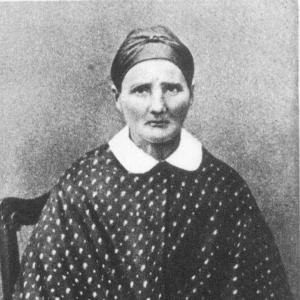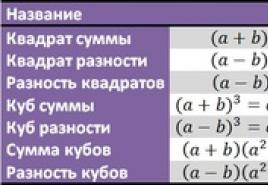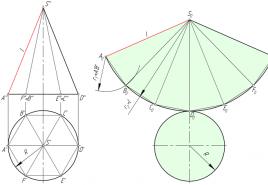How to divide an equation with a corner. Division of polynomials
Let's start with some definitions. An expression of the form $ P_n (x) = \ sum \ limits_ (i = 0) ^ (n) a_ (i) x ^ (ni) = a_ (0) x ^ (n) + a_ (1) x ^ (n-1) + a_ (2) x ^ (n-2) + \ ldots + a_ (n-1) x + a_n $. For example, the expression $ 4x ^ (14) + 87x ^ 2 + 4x-11 $ is a polynomial whose degree is $ 14 $. It can be denoted like this: $ P_ (14) (x) = 4x ^ (14) + 87x ^ 2 + 4x-11 $.
The coefficient $ a_0 $ is called the leading coefficient of the polynomial $ P_n (x) $. For example, for the polynomial $ 4x ^ (14) + 87x ^ 2 + 4x-11 $, the leading coefficient is $ 4 $ (the number in front of $ x ^ (14) $). The number $ a_n $ is called the free term of the polynomial $ P_n (x) $. For example, for $ 4x ^ (14) + 87x ^ 2 + 4x-11 $, the intercept is $ (- 11) $. Now let's turn to the theorem, on which, in fact, the presentation of the material on this page will be based.
For any two polynomials $ P_n (x) $ and $ G_m (x) $, one can find polynomials $ Q_p (x) $ and $ R_k (x) $ such that the equality
\ begin (equation) P_n (x) = G_m (x) \ cdot Q_p (x) + R_k (x) \ end (equation)
and $ k< m$.
The phrase "divide the polynomial $ P_n (x) $ by the polynomial $ G_m (x) $" means "to represent the polynomial $ P_n (x) $ in the form (1)". We will call the polynomial $ P_n (x) $ - divisible, the polynomial $ G_m (x) $ - the divisor, the polynomial $ Q_p (x) $ - the quotient of $ P_n (x) $ by $ G_m (x) $, and the polynomial $ R_k (x) $ is the remainder of dividing $ P_n (x) $ by $ G_m (x) $. For example, for polynomials $ P_6 (x) = 12x ^ 6 + 3x ^ 5 + 16x ^ 4 + 6x ^ 3 + 8x ^ 2 + 2x + 1 $ and $ G_4 (x) = 3x ^ 4 + 4x ^ 2 + 2 $ you can get such equality:
$$ 12x ^ 6 + 3x ^ 5 + 16x ^ 4 + 6x ^ 3 + 8x ^ 2 + 2x + 1 = (3x ^ 4 + 4x ^ 2 + 2) (4x ^ 2 + x) + 2x ^ 3 + 1 $$
Here the polynomial $ P_6 (x) $ is divisible, the polynomial $ G_4 (x) $ is a divisor, the polynomial $ Q_2 (x) = 4x ^ 2 + x $ is the quotient of $ P_6 (x) $ by $ G_4 (x) $, and the polynomial $ R_3 (x) = 2x ^ 3 + 1 $ is the remainder of the division of $ P_6 (x) $ by $ G_4 (x) $. Note that the degree of the remainder (i.e., 3) is less than the degree of the divisor, (i.e., 4), therefore, the equality condition is met.
If $ R_k (x) \ equiv 0 $, then the polynomial $ P_n (x) $ is said to be divisible by the polynomial $ G_m (x) $ without a remainder. For example, the polynomial $ 21x ^ 6 + 6x ^ 5 + 105x ^ 2 + 30x $ is divisible by the polynomial $ 3x ^ 4 + 15 $ without a remainder, since the equality holds:
$$ 21x ^ 6 + 6x ^ 5 + 105x ^ 2 + 30x = (3x ^ 4 + 15) \ cdot (7x ^ 2 + 2x) $$
Here the polynomial $ P_6 (x) = 21x ^ 6 + 6x ^ 5 + 105x ^ 2 + 30x $ is divisible; polynomial $ G_4 (x) = 3x ^ 4 + 15 $ - divisor; and the polynomial $ Q_2 (x) = 7x ^ 2 + 2x $ is the quotient of $ P_6 (x) $ divided by $ G_4 (x) $. The remainder is zero.
To divide a polynomial into a polynomial, division by "column" or, as it is also called, "corner" is often used. Let's take a look at the implementation of this method using examples.
Before moving on to examples, I will introduce one more term. He is not generally accepted, and we will use it solely for the convenience of presenting the material. Until the end of this page, we will call the expression $ a_ (0) x ^ (n) $ as the leading element of the polynomial $ P_n (x) $. For example, for the polynomial $ 4x ^ (14) + 87x ^ 2 + 4x-11 $, the leading element is $ 4x ^ (14) $.
Example # 1
Divide $ 10x ^ 5 + 3x ^ 4-12x ^ 3 + 25x ^ 2-2x + 5 $ by $ 5x ^ 2-x + 2 $ using long division.
So, we have two polynomials, $ P_5 (x) = 10x ^ 5 + 3x ^ 4-12x ^ 3 + 25x ^ 2-2x + 5 $ and $ G_2 (x) = 5x ^ 2-x + 2 $. The degree of the first is $ 5 $ and the degree of the second is $ 2 $. The polynomial $ P_5 (x) $ is the divisor, and the polynomial $ G_2 (x) $ is the divisor. Our task is to find the quotient and the remainder. We will solve the set task step by step. We will use the same notation as for dividing numbers:
First step
We divide the highest element of the polynomial $ P_5 (x) $ (i.e. $ 10x ^ 5 $) by the highest element of the polynomial $ Q_2 (x) $ (i.e. $ 5x ^ 2 $):
$$ \ frac (10x ^ 5) (5x ^ 2) = 2x ^ (5-2) = 2x ^ 3. $$
The resulting expression $ 2x ^ 3 $ is the first element of the quotient:

Multiply the polynomial $ 5x ^ 2-x + 2 $ by $ 2x ^ 3 $, getting:
$$ 2x ^ 3 \ cdot (5x ^ 2-x + 2) = 10x ^ 5-2x ^ 4 + 4x ^ 3 $$
Let's write down the result:
Now we subtract from the polynomial $ 10x ^ 5 + 3x ^ 4-12x ^ 3 + 25x ^ 2-2x + 5 $ the polynomial $ 10x ^ 5-2x ^ 4 + 4x ^ 3 $:
$$ 10x ^ 5 + 3x ^ 4-12x ^ 3 + 25x ^ 2-2x + 5- (10x ^ 5-2x ^ 4 + 4x ^ 3) = 5x ^ 4-16x ^ 3 + 25x ^ 2-2x + 5 $$

This concludes the first step. The result that we got can be written in expanded form:
$$ 10x ^ 5 + 3x ^ 4-12x ^ 3 + 25x ^ 2-2x + 5 = (5x ^ 2-x + 2) \ cdot 2x ^ 3 + 5x ^ 4-16x ^ 3 + 25x ^ 2-2x +5 $$
Since the degree of the polynomial $ 5x ^ 4-16x ^ 3 + 25x ^ 2-2x + 5 $ (i.e. 4) is greater than the degree of the polynomial $ 5x ^ 2-x + 2 $ (i.e. 2), then the process division must be continued. Let's move on to the second step.
Second step
Now we will work with the polynomials $ 5x ^ 4-16x ^ 3 + 25x ^ 2-2x + 5 $ and $ 5x ^ 2-x + 2 $. In the same way as in the first step, we divide the top element of the first polynomial (i.e. $ 5x ^ 4 $) by the highest element of the second polynomial (i.e. $ 5x ^ 2 $):
$$ \ frac (5x ^ 4) (5x ^ 2) = x ^ (4-2) = x ^ 2. $$
The resulting expression $ x ^ 2 $ is the second element of the quotient. Add to the quotient $ x ^ 2 $

Multiply the polynomial $ 5x ^ 2-x + 2 $ by $ x ^ 2 $, getting:
$$ x ^ 2 \ cdot (5x ^ 2-x + 2) = 5x ^ 4-x ^ 3 + 2x ^ 2 $$
Let's write down the result:

Now subtract from the polynomial $ 5x ^ 4-16x ^ 3 + 25x ^ 2-2x + 5 $ the polynomial $ 5x ^ 4-x ^ 3 + 2x ^ 2 $:
$$ 5x ^ 4-16x ^ 3 + 25x ^ 2-2x + 5- (5x ^ 4-x ^ 3 + 2x ^ 2) = - 15x ^ 3 + 23x ^ 2-2x + 5 $$
We add this polynomial under the line:

This concludes the second step. The resulting result can be written in expanded form:
$$ 10x ^ 5 + 3x ^ 4-12x ^ 3 + 25x ^ 2-2x + 5 = (5x ^ 2-x + 2) \ cdot (2x ^ 3 + x ^ 2) -15x ^ 3 + 23x ^ 2 -2x + 5 $$
Since the degree of the polynomial $ -15x ^ 3 + 23x ^ 2-2x + 5 $ (i.e. 3) is greater than the degree of the polynomial $ 5x ^ 2-x + 2 $ (i.e. 2), we continue the division process. Let's move on to the third step.
Third step
Now we will work with the polynomials $ -15x ^ 3 + 23x ^ 2-2x + 5 $ and $ 5x ^ 2-x + 2 $. In the same way as in the previous steps, we divide the highest element of the first polynomial (i.e. $ -15x ^ 3 $) by the highest element of the second polynomial (i.e. $ 5x ^ 2 $):
$$ \ frac (-15x ^ 3) (5x ^ 2) = - 3x ^ (2-1) = - 3x ^ 1 = -3x. $$
The resulting expression $ (- 3x) $ is the third element of the quotient. Add $ -3x $ to the quotient

Multiply the polynomial $ 5x ^ 2-x + 2 $ by $ (- 3x) $, getting:
$$ -3x \ cdot (5x ^ 2-x + 2) = - 15x ^ 3 + 3x ^ 2-6x $$
Let's write down the result:

Now we subtract from the polynomial $ -15x ^ 3 + 23x ^ 2-2x + 5 $ the polynomial $ -15x ^ 3 + 3x ^ 2-6x $:
$$ -15x ^ 3 + 23x ^ 2-2x + 5 - (- 15x ^ 3 + 3x ^ 2-6x) = 20x ^ 2 + 4x + 5 $$
We add this polynomial under the line:

This concludes the third step. The resulting result can be written in expanded form:
$$ 10x ^ 5 + 3x ^ 4-12x ^ 3 + 25x ^ 2-2x + 5 = (5x ^ 2-x + 2) \ cdot (2x ^ 3 + x ^ 2-3x) + 20x ^ 2 + 4x +5 $$
Since the degree of the polynomial $ 20x ^ 2 + 4x + 5 $ (i.e. 2) is equal to the degree of the polynomial $ 5x ^ 2-x + 2 $ (i.e. 2), we continue the division process. Let's move on to the fourth step.
Fourth step
Now we will work with the polynomials $ 20x ^ 2 + 4x + 5 $ and $ 5x ^ 2-x + 2 $. In the same way as in the previous steps, we divide the top element of the first polynomial (i.e. $ 20x ^ 2 $) by the highest element of the second polynomial (i.e. $ 5x ^ 2 $):
$$ \ frac (20x ^ 2) (5x ^ 2) = 4x ^ (2-2) = 4x ^ 0 = 4. $$
The resulting number $ 4 $ is the fourth element of the quotient. Add $ 4 to the private

Multiply the polynomial $ 5x ^ 2-x + 2 $ by $ 4 $, getting:
$$ 4 \ cdot (5x ^ 2-x + 2) = 20x ^ 2-4x + 8 $$
Let's write down the result:

Now subtract from the polynomial $ 20x ^ 2 + 4x + 5 $ the polynomial $ 20x ^ 2-4x + 8 $.
Statement
the remainder incomplete private.
Comment
For any polynomials $ A (x) $ and $ B (x) $ (the degree of $ B (x) $ is greater than 0), there are unique polynomials $ Q (x) $ and $ R (x) $ from the condition of the statement.
- The remainder of the division of the polynomial $ x ^ (4) + 3x ^ (3) + 5 $ by $ x ^ (2) + 1 $ is $ 3x + 4 $: $ x ^ (4) + 3x ^ (3) +5 = (x ^ (2) + 3x +1) (x ^ (2) + 1) + 3x + 4. $
- The remainder of the division of the polynomial $ x ^ (4) + 3x ^ (3) + 5 $ by $ x ^ (4) + 1 $ is $ 3x ^ (3) + 4 $: $ x ^ (4) + 3x ^ ( 3) +5 = 1 \ cdot (x ^ (2) + 1) + 3x ^ (3) + 4. $
- The remainder of dividing the polynomial $ x ^ (4) + 3x ^ (3) + 5 $ by $ x ^ (6) + 1 $ is $ x ^ (4) + 3x ^ (3) +5 $: $ x ^ ( 4) + 3x ^ (3) +5 = 0 \ cdot (x ^ (6) + 1) + x ^ (4) + 3x ^ (3) + 5. $
Statement
For any two polynomials $ A (x) $ and $ B (x) $ (where the degree of the polynomial $ B (x) $ is nonzero), there is a representation in the form of a polynomial $ A (x) $ in the form $ A (x) = Q (x) B (x) + R (x) $, where $ Q (x) $ and $ R (x) $ are polynomials and the degree of $ R (x) $ is less than the degree of $ B (x). $
Proof
We will prove the statement by induction on the degree of the polynomial $ A (x). $ Denote it by $ n $. If $ n = 0 $, the statement is true: $ A (x) $ can be represented as $ A (x) = 0 \ cdot B (x) + A (x). $ Now, let the statement be proved for polynomials of degree $ n \ leq m $. Let us prove the assertion for polynomials of degree $ k = n + 1. $
Let the degree of the polynomial $ B (x) $ be equal to $ m $. Consider three cases: $ k< m$, $k = m$ и $k >m $ and prove the assertion for each of them.
- $ k< m$
The polynomial $ A (x) $ can be represented as$ A (x) = 0 \ cdot B (x) + A (x). $
The assertion is complete.
- $ k = m $
Let the polynomials $ A (x) $ and $ B (x) $ have the form$ A (x) = a_ (n + 1) x ^ (n + 1) + a_ (n) x ^ (n) + \ dots + a_ (1) x + a_ (0), \: \ mbox (where ) \: a_ (n + 1) \ neq 0; $
$ B (x) = b_ (n + 1) x ^ (n + 1) + b_ (n) x ^ (n) + \ dots + b_ (1) x + b_ (0), \: \ mbox (where ) \: b_ (n + 1) \ neq 0. $
We represent $ A (x) $ as
$ A (x) = \ dfrac (a_ (n + 1)) (b_ (n + 1)) B (x) - \ Big (\ dfrac (a_ (n + 1)) (b_ (n + 1)) B (x) - A (x) \ Big). $
Note that the degree of the polynomial $ \ dfrac (a_ (n + 1)) (b_ (n + 1)) B (x) - A (x) $ is at most $ n + 1 $, then this representation is the desired one and the statement is satisfied.
- $ k> m $
We represent the polynomial $ A (x) $ as$ A (x) = x (a_ (n + 1) x ^ (n) + a_ (n) x ^ (n-1) + \ dots + a_ (1)) + a_ (0), \: \ mbox (where) \: a_ (n + 1) \ neq 0. $
Consider the polynomial $ A "(x) = a_ (n + 1) x ^ (n) + a_ (n) x ^ (n-1) + \ dots + a_ (1). $ The induction hypothesis holds for it, therefore can be represented as $ A "(x) = Q" (x) B (x) + R "(x) $, where the degree of the polynomial $ R" (x) $ is less than $ m $, then the representation for $ A (x) $ can be rewritten as
$ A (x) = x (Q "(x) B (x) + R" (x)) + a_ (0) = xQ "(x) B (x) + xR" (x) + a_ (0) . $
Note that the degree of the polynomial $ xR "(x) $ is less than $ m + 1 $, that is, less than $ k $. Then the induction hypothesis holds for $ xR" (x) $ and can be represented as $ xR "(x) = Q" "(x) B (x) + R" "(x) $, where the degree of the polynomial $ R" "(x) $ is less than $ m $. Rewrite the representation for $ A (x) $ how
$ A (x) = xQ "(x) B (x) + Q" "(x) B (x) + R" "(x) + a_ (0) = $
$ = (xQ "(x) + xQ" "(x)) B (x) + R" "(x) + a_ (0). $
The degree of the polynomial $ R "" (x) + a_ (0) $ is less than $ m $, so the statement is true.
The statement is proven.
Moreover, the polynomial $ R (x) $ is called the remainder from dividing $ A (x) $ by $ B (x) $, and $ Q (x) $ - incomplete private.
If the remainder $ R (x) $ is a zero polynomial, then $ A (x) $ is said to be divisible by $ B (x) $.
Today we will learn how to divide polynomials by each other, and we will perform the division with a corner by analogy with ordinary numbers. This is a very useful technique that, unfortunately, is not taught in most schools. Therefore, listen carefully to this video tutorial. There is nothing difficult in such a division.
First, let's divide the two numbers by each other:
How can you do this? First of all, we cut off so many digits so that the resulting numerical value is greater than the one by which we are dividing. If we cut off one bit, we get five. Obviously seventeen doesn’t fit in five, so it’s not enough. We take two digits - we will get 59 - it is already more than seventeen, so we can perform the operation. So how many times does seventeen fit in 59? Let's take three. We multiply and write down the result under 59. In total, we got 51. Subtract and we got “eight”. Now we demolish the next category - five. Divide 85 by seventeen. We take five. We multiply seventeen by five and get 85. Subtract and we get zero.
We solve real-life examples
Problem number 1
Now let's follow the same steps, but not with numbers, but with polynomials. Let's take this as an example:
\ [\ frac (((x) ^ (2)) + 8x + 15) (x + 5) = x + 3 \]
Please note, if, when dividing numbers by each other, we meant that the dividend is always greater than the divisor, then in the case of dividing the polynomials with an angle, it is necessary that the degree of the dividend is greater than the divisor. In our case, everything is in order - we work with constructions of the second and first degree.
So the first step: compare the first elements. Question: what do you need to multiply $ x $ to get $ ((x) ^ (2)) $? Obviously one more $ x $. Multiply $ x + 5 $ by the number we just found, $ x $. We have $ ((x) ^ (2)) + 5 $, which we subtract from the dividend. $ 3x $ remaining. Now we demolish the next term - fifteen. Let's look at the first elements again: $ 3x $ and $ x $. What should $ x $ be multiplied by to get $ 3x $? Obviously three. Multiply $ x + 5 $ term by three. When we subtract, we get zero.
As you can see, the whole operation of division with a corner has been reduced to comparing the higher coefficients for the dividend and the divisor. It's even easier than dividing numbers. There is no need to allocate a certain number of digits - we just compare the senior elements at each step. That's the whole algorithm.
Problem number 2
Let's try again:
\ [\ frac (((x) ^ (2)) + x-2) (x-1) = x + 2 \]
First step: let's look at the higher odds. How much do you need to multiply $ x $ to write $ ((x) ^ (2)) $? We multiply term by term. Please note that when subtracting, we get exactly $ 2x $, because
We demolish -2 and again compare the first obtained coefficient with the leading element of the divisor. All in all, we got a "nice" answer.
Let's move on to the second example:
\ [\ frac (((x) ^ (3)) + 2 ((x) ^ (2)) - 9x-18) (x + 3) = ((x) ^ (2)) - x-6 \ ]
This time, the dividend is a polynomial of the third degree. Let's compare the first elements. To get $ ((x) ^ (3)) $, you need to multiply $ x $ by $ ((x) ^ (2)) $. After subtracting, we demolish $ 9x $. Multiply the divisor by $ -x $ and subtract. As a result, our expression was completely split. We write down the answer.
Problem number 3
Moving on to the last task:
\ [\ frac (((x) ^ (3)) + 3 ((x) ^ (2)) + 50) (x + 5) = ((x) ^ (2)) - 2x + 10 \]
Compare $ ((x) ^ (3)) $ and $ x $. Obviously, you need to multiply by $ ((x) ^ (2)) $. As a result, we see that we received a very "nice" answer. We write it down.
That's the whole algorithm. There are two key points here:
- Always compare the first power of the dividend and the divisor - we repeat this at each step;
- If any powers are missing in the original expression, they must be added when dividing with a corner, but with zero coefficients, otherwise the answer will be incorrect.
There are no more subtleties and tricks in this division.
The material of today's lesson is nowhere and never found in its "pure" form. It is rarely taught in schools. However, the ability to divide polynomials by each other will greatly help you when solving equations of higher degrees, as well as all kinds of problems of "increased difficulty". Without this technique, you will have to factor out polynomials, select coefficients - and the result is by no means guaranteed. However, polynomials can also be divided by a corner - just like ordinary numbers! Unfortunately, this technique is not taught in schools. Many teachers believe that dividing polynomials by an angle is something insanely difficult, from the field of higher mathematics. I hasten to assure you: this is not the case. What's more, polynomials are even easier to divide than regular numbers! Watch the lesson - and see for yourself. :) In general, be sure to take this technique into service. The ability to divide polynomials by each other will be very useful to you when solving equations of higher degrees and in other non-standard problems.
I hope this video will help those who work with polynomials, especially higher degrees. This applies to both high school students and university students. And that's all for me. See you!
This article will consider the rational fraction, its allocation of whole parts. Fractions can be right and wrong. When the numerator in the fraction is less than the denominator, this is a correct fraction, and the opposite is incorrect.
Consider examples of regular fractions: 1 2, 9 29, 8 17, incorrect: 16 3, 21 20, 301 24.
We will calculate fractions that can be canceled, that is, 12 16 is 3 4, 21 14 is 3 2.
When selecting an integer part, the process of dividing the numerator by the denominator is performed. Then such a fraction can be represented as the sum of the integer and fractional parts, where the fractional is considered the ratio of the remainder of the division and the denominator.
Example 1
Find the remainder when 27 is divided by 4.
Solution
It is necessary to make a division by a column, then we get that
This means that 27 4 = whole part + about the remaining value = 6 + 3 4
Answer: remainder 3.
Example 2
Select whole parts 331 12 and 41 57.
Solution
We divide the denominator by the numerator using a corner:


Therefore, we have that 331 12 = 27 + 7 12.
The second fraction is correct, which means that the whole part is equal to zero.
Answer: whole parts 27 and 0.
Consider the classification of polynomials, in other words, a fractional rational function. It is considered correct when the degree of the numerator is less than the degree of the denominator, otherwise it is considered incorrect.
Definition 1
Dividing a polynomial by a polynomial occurs according to the principle of division by an angle, and the presentation of the function as the sum of the integer and fractional parts.
To divide a polynomial into a linear binomial, Horner's scheme is used.
Example 3
Divide x 9 + 7 x 7 - 3 2 x 3 - 2 by a monomial 2 x 2.
Solution
Using the property of division, we write that
x 9 + 7 x 7 - 3 2 x 3 - 2 2 x 2 = x 9 2 x 2 + 7 x 7 2 x 2 - 3 2 x 3 2 x 2 + x 2 2 x 2 - 2 2 x 2 = = 1 2 x 7 + 7 2 x 5 - 3 4 x + 1 2 - 2 2 x - 2.
Often this type of transformation is performed when taking integrals.
Example 4
Divide a polynomial by a polynomial: 2 x 3 + 3 by x 3 + x.
Solution
The division sign can be written as a fraction like 2 x 3 + 3 x 3 + x. Now you need to select the whole part. We do this using long division. We get that

So, we get that the integer part has the value - 2 x + 3, then the whole expression is written as 2 x 3 + 3 x 3 + x = 2 + - 2 x + 3 x 3 + x
Example 5
Divide and find the remainder of 2 x 6 - x 5 + 12 x 3 - 72 x 2 + 3 by x 3 + 2 x 2 - 1.
Solution
Let us fix a fraction of the form 2 x 6 - x 5 + 12 x 3 - 72 x 2 + 3 x 3 + 2 x 2 - 1.
The degree of the numerator is greater than that of the denominator, which means that we have an incorrect fraction. Select the whole part using long division. We get that

Let's divide again and get:

Hence we have that the remainder is equal to - 65 x 2 + 10 x - 3, from which it follows:
2 x 6 - x 5 + 12 x 3 - 72 x 2 + 3 x 3 + 2 x 2 - 1 = 2 x 3 - 5 x 2 + 10 x - 6 + - 65 x 2 + 10 x - 3 x 3 + 2 x 2 - 1
There are cases where it is necessary to additionally perform the transformation of the fraction in order to be able to identify the remainder of the division. It looks like this:
3 x 5 + 2 x 4 - 12 x 2 - 4 x 3 - 3 = 3 x 2 x 3 - 3 - 3 x 2 x 3 - 3 + 3 x 5 + 2 x 4 - 12 x 2 - 4 x 3 - 3 = = 3 x 2 x 3 - 3 + 2 x 4 - 3 x 2 - 4 x 3 - 3 = 3 x 2 + 2 x 4 - 3 x 2 - 4 x 3 - 3 = = 3 x 2 + 2 xx 3 - 3 - 2 xx 3 - 3 + 2 x 4 - 3 x 2 - 4 x 3 - 3 = = 3 x 2 + 2 x (x 3 - 3) - 3 x 2 + 6 x - 4 x 3 - 3 = 3 x 2 + 2 x + - 3 x 2 + 6 x - 4 x 3 - 3
This means that the remainder when dividing 3 x 5 + 2 x 4 - 12 x 2 - 4 by x 3 - 3 gives the value - 3 x 2 + 6 x - 4. To quickly find the result, use the abbreviated multiplication formulas.
Example 6
Divide 8 x 3 + 36 x 2 + 54 x + 27 by 2 x + 3.
Solution
Let's write the division as a fraction. We get 8 x 3 + 36 x 2 + 54 x + 27 2 x + 3. Note that the expression in the numerator can be added using the sum cube formula. We have that
8 x 3 + 36 x 2 + 54 x + 27 2 x + 3 = (2 x + 3) 3 2 x + 3 = (2 x + 3) 2 = 4 x 2 + 12 x + 9
The given polynomial is divisible without a remainder.
For the solution, a more convenient solution method is used, and the division of a polynomial by a polynomial is considered to be the most universal, therefore, it is often used when isolating an integer part. The final record should contain the resulting polynomial from division.
If you notice an error in the text, please select it and press Ctrl + Enter
Let it be required
(2x 3 - 7x 2 + x + 1) ÷ (2x - 1).
Here the product (2x 3 - 7x 2 + x + 1) and one factor (2x - 1) are given, - you need to find another factor. In this example, it is immediately clear (but in general this cannot be established) that the other, sought, factor, or quotient, is also a polynomial. This is clear because this product has 4 terms, and this factor is only 2. However, it is impossible to say in advance how many terms the desired factor has: there may be 2 terms, 3 terms, etc. Recalling that the leading term of the product always turns out from multiplying the leading term of one factor by the leading term of another (see multiplication of a polynomial by a polynomial) and that there can be no terms like this, we are sure that 2x 3 (the most significant term of this product) will be obtained from multiplying 2x (the leading term of this factor ) by the unknown senior member of the desired factor. To find the latter, you have to, therefore, divide 2x 3 by 2x - we get x 2. This is the senior member of the private.
Recall then that when a polynomial is multiplied by a polynomial, you have to multiply each term of one polynomial by each term of the other. Therefore, this product (2x 3 - 7x 2 + x + 1) is the product of the divisor (2x - 1) by all terms of the quotient. But we can now find the product of the divisor by the first (most significant) term of the quotient, that is, (2x - 1) ∙ x 2; we get 2x 3 - x 2. Knowing the product of the divisor by all terms of the quotient (it = 2x 3 - 7x 2 + x + 1) and knowing the product of the divisor by the 1st term of the quotient (it = 2x 3 - x 2), by subtraction we can find the product of the divisor by all the others, except for the 1st, members of the private. We get
(2x 3 - 7x 2 + x + 1) - (2x 3 - x 2) = 2x 3 - 7x 2 + x + 1 - 2x 3 + x 2 = –6x 2 + x + 1.
The most significant term (–6x 2) of this remaining product must represent the product of the most significant term of the divisor (2x) by the most significant term of the rest (except for the 1st term) of the quotient. From here we find the senior member of the rest of the private. We need –6x 2 ÷ 2x, we get –3x. This is the second term of the sought-for quotient. We can again find the product of the divisor (2x - 1) by the second, just found, term of the quotient, that is, by –3x.
We get (2x - 1) ∙ (–3x) = –6x 2 + 3x. From this whole product, we have already subtracted the product of the divisor by the 1st term of the quotient and got the remainder –6x 2 + x + 1, which is the product of the divisor by the other, except for the 1st, members of the quotient. Subtracting from it the product just found –6x 2 + 3x, we get the remainder, which is the product of the divisor by all the other, except for the 1st and 2nd, members of the quotient:
–6x 2 + x + 1 - (–6x 2 + 3x) = –6x 2 + x + 1 + 6x 2 - 3x = –2x + 1.
Dividing the senior term of this remaining product (–2x) by the senior term of the divisor (2x), we get the senior term of the rest of the quotient, or its third term, (–2x) ÷ 2x = –1, - this is the 3rd term of the quotient.
Multiplying the divisor by it, we get
(2x - 1) ∙ (–1) = –2x + 1.
Subtracting this product of the divisor by the 3rd term of the quotient from the entire product remaining so far, i.e.
(–2x + 1) - (–2x + 1) = –2x + 1 + 2x - 1 = 0,
we will see that in our example the product is divided into the rest, except for the 1st, 2nd and 3rd, members of the quotient = 0, from which we conclude that the quotient has no more members, i.e.
(2x 3 - 7x 2 + x + 1) ÷ (2x - 1) = x 2 - 3x - 1.
From the previous one, we see: 1) it is convenient to arrange the terms of the dividend and divisor in descending powers, 2) it is necessary to establish some order for performing the calculations. Such a convenient order can be considered the one that is used in arithmetic when dividing multi-digit numbers. Following it, we arrange all the previous calculations as follows (some more brief explanations are given on the side):
Those subtractions that are needed here are performed by changing the signs of the terms of the subtracted, and these variable signs are written from above.
So, it is written
This means: the subtracted was 2x 3 - x 2, and after the change of signs we got –2x 3 + x 2.
Due to the accepted arrangement of calculations, due to the fact that the terms of the dividend and the divisor are arranged in descending degrees and due to the fact that the degrees of the letter x in both polynomials go down every time by 1, it turned out that similar terms are written under each other (for example: –7x 2 and + x 2), why it is easy to cast them. You can notice that not all members of the dividend are needed at every moment of the calculation. For example, the +1 term is not needed at the moment where the 2nd term of the quotient was found, and this part of the calculations can be simplified.

More examples:
1. (2a 4 - 3ab 3 - b 4 - 3a 2 b 2) ÷ (b 2 + a 2 + ab).
Let us arrange the letters a and the dividend and the divisor in descending powers:

(Note that here, due to the absence of the term with a 3 in the dividend, in the first subtraction it turned out that not similar terms –a 2 b 2 and –2a 3 b are signed under each other. Of course, they cannot be reduced to one term and both are written under the line by seniority).

In both examples, you need to be more careful about similar members: 1) not similar terms are often written below each other, and 2) sometimes (like, for example, in the last example, the terms –4a n and –an at the first subtraction) similar terms come out written not under each other.
It is possible to perform division of polynomials in a different order, namely: each time to look for the lowest term or all or the remaining quotient. It is convenient in this case to arrange these polynomials in ascending powers of any letter. For example:








